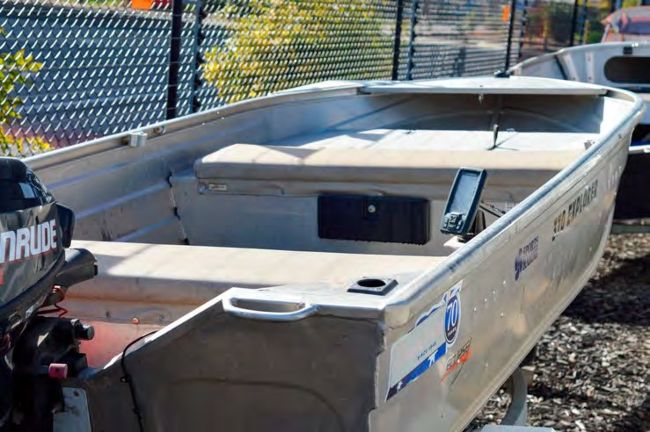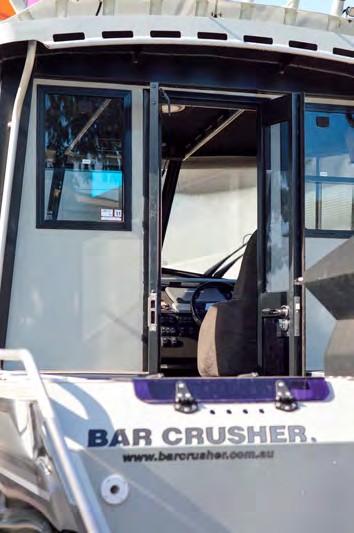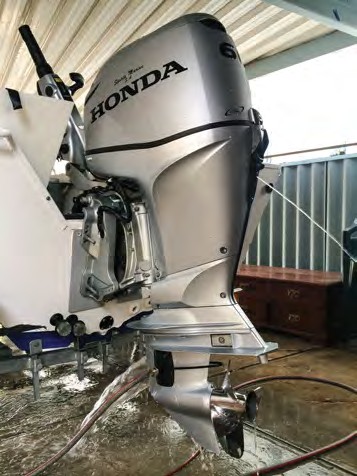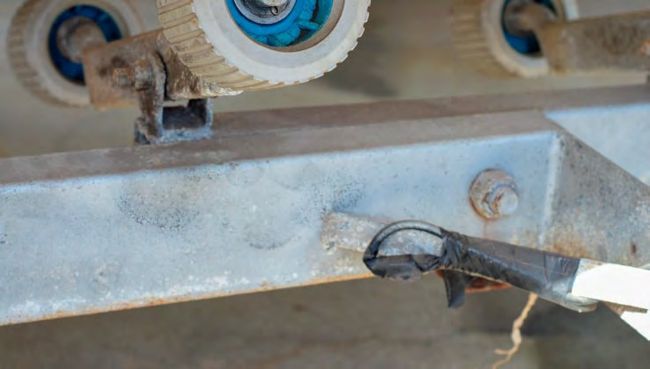A BEGINNER’S GUIDE TO BOAT BUYING
Avoiding the Pitfalls
Max Fischer provides some timely advice on what to watch out for when buying your first boat. There are plenty of traps for young players!
You’ve grown tired of being land based. You’re tired of the crowds and the restricted access. You’ve seen the images on forums and social media pages of full creels, and feel that it’s time to spread your wings. A boat will help you do that, but you don’t know where to start. You’re not sure what to buy or what all the terms in the numerous ads mean. My aim in this article is to help with all that and talk you through what boat ownership means to help you on your nautical journey.
Buying a boat, any boat, is simple. Heck, you don’t even need a boat licence to buy a boat! Buying the right boat for you, however, is a little more difficult and there is a lot of thought and investigation required to ensure your money is well spent.
Some might argue that setting a budget is the first step. In my opinion, the first step is deciding what type of vessel to buy and by this I don’t mean fibreglass, aluminium or plastic. Yes, plastic boats do exist and are very practical. I mean deciding on what you hope to use the boat for. There is little point going out and buying a 6m cabin boat if you intend to be fishing a local river or estuary throwing lures into structure where access maybe restricted. Just as it is pointless buying an American-style bass boat to fish the deep reefs or offshore. Neither is practical for the intended task. I’ll try and break this down into two types – open boats and cabin boats.
An open boat usually steers from the rear, or tiller. It could also include side or centre consoles. These are perhaps the most practical option if casting lures is your preferred method of fishing. This can be as simple as throwing plugs at the likes of bream and salmon trout all the way up to casting larger stick baits at the likes of tuna or kingfish. An open boat allows the freedom to cast at will without the worry of catching canopies, rocket launchers, or cabins. It also allows room for more anglers to be casting as the whole boat becomes a platform.

Your budget will always be a significant factor
Cabin boats, as the name implies, have a cabin that allows respite from the weather, somewhere to keep personal items or rest, but also restrict the amount of usable fishing space. These types of boats are popular with families because of the ability for people to relax out of the sun or wind if the fishing allows it. There is another type referred to as a cuddy cabin or simply cuddy. A cuddy is simply a smaller cabin or what could also be described as a wind breaker. They will offer some protection, but usually lack anywhere to rest and will have limited storage space.
Another type is the runabout, which usually has front steering with just a windscreen for protection. Further protection can be added by way of a Bimini top and clears, and the forward steering position allows more deck space than a cuddy or cabin boat of similar size.
So, you’ve decided on the type of fishing you’re likely to be doing, and decided on one or the other style of boat. Now is the time to look at your budget and see if the vessel you seek falls within it. If it does, great. If not, you may need to reassess your hopes and aspirations. Let me explain. You’ve decided that you want a 4.5-5m cabin boat to head off far ‘n’ wide to chase the glory species – snapper and whiting. The temptation might be to look for something cheap to reach this goal, but cheap can become expensive very fast. I say expensive because if the boat is problematic – and cheap usually is – you’ll find excuses not to use it and your bargain buy will just be an expensive garden ornament. In this case, lowering the expectation a little can still have you on the water, albeit fishing closer to shore. It’s here that the humble, yet highly versatile tinnie comes into its own. While offering limited to no protection from the weather, a tinnie, or small fibreglass version, will allow you the opportunity to reach water not available to you from the shore.
Motor size is dictated to an extent by hull size and the two will dictate how far out or along the coast you can travel. However, a suitable sized tinnie can be launched almost anywhere, so the need to travel long distances to a spot can be negated by this. Fishing along the blue line is an easy task for vessels of this style, and one can still expect to catch the likes of whiting, garfish, tommies and squid.

So, the type of boat has been picked and it’s time to start shopping. Where once we would look in the favoured Trading Post, the internet has brought us a new way of searching for items. Apps like Facebook Marketplace, Boatsales.com or any of the vast number of boat selling pages on Facebook can provide a visual of what they are looking at before even leaving the house. When I have come across a vessel I am interested in, I usually start with a few questions that are not always mentioned in the ad; things like when the pictures were taken, and if they are recent or older pics from days on the water. You can usually tell, but not always.
Are there service records for the outboard? Modern outboards are a world away from older versions. Even those with what some may consider a high number of hours can still be reliable units with many more years of life left in them if they have been properly maintained and cared for. A good service history shows that the owner has looked after the vessel and for me at least, has some value when negotiating the price. After the outboard and hull, the trailer has to be the most important item of the whole rig. After all, it’s what gets the boat from home to the water and back again. A poor quality trailer will cost a great deal to repair or replace, so look at this carefully. Be prepared to get onto the ground and look at the trailer from underneath as well as above, as it’s underneath that problems could be hidden.

Most of the big-name engines will serve you well
I like to take a small hammer with me for older square tube galvanised trailers. A light tap in areas will help show if the tube is solid or if there is serious decay not easily seen from the outside. Also check things like the tyres. Are they in good condition or will they need replacing soon? Cracked sidewalls won’t make for an uneventful trip somewhere down the line. Check that the winch strap is in good condition and free from tears. If it has a wire rope, check that its condition is good and not rusted away, being a danger to someone. Especially so with heavier boats, I have seen rusted wire winch cables let go mid retrieve and trust me, it’s a dangerous thing if it hits you or someone nearby.
Ensure the lights work too! These are all extras you will need to place your hand in your pocket for if faulty, so ensure you are getting what you pay for. A suitable spare wheel is also a handy thing to have, and if not supplied with the boat, is something you should consider getting sooner rather than later. It’s important too to make sure that the trailer is set up correctly. A poorly set up trailer can make launching and retrieving difficult and let’s face it, the more difficult the whole outing is, the less likely you are to be out enjoying your boat.

Above and beneath the trailer should always be inspected carefully!
You’ve checked over the hull, the motor and the trailer and it’s all fine, but you are not finished yet. There are still more things to check. The boat has been advertised with a myriad of extras – things like echo sounders, bilge/ live bait pumps, navigation lights and radios. Check each and ever y item. Check that they are there and that they work. A $4,000, 12”echo sounder/chart plotter is worthless if not operational, and I bet the seller has used the sounder as a value adding item when pricing the boat. So, check it. Out on the water with a hull full of water is not the time to find out that the bilge pump does not work, so again, check it. Electrical work is equally as expensive as mechanical work, so if things are not working, you need to factor this into the price you pay initially.
To this point it’s all gone down smoothly. You’ve bought the boat, arranged insurance and transferred the registrations and it’s time to hit the water. Now a few words of advice. A busy boat ramp on a glorious sunny day is NOT the time to practise your trailer reversing skills or to learn how to do it. Instead, spend some time in a suitable area practising this skill. An empty shopping centre carpark would be ideal. There is little to hit, and you can easily get the skills and confidence to back that bad boy like a pro!
Launching and retrieving is another thing that many do not understand. Get EVERYTHING ready well ahead of the time you back down to the water’s edge. Bungs, bow and stern line are obvious. Load the boat with all the day’s requirements, food drink and tackle all away from the launching area. This will help make the process of the launch seamless and fast.
With retrieving, DON’T sink the trailer. The trailer should be set up and immersed to allow it to grab the boat’s hull and straighten it as its winched on. The exception here is when driving the boat onto the trailer, however. Personally, I like to have the last roller just touching the water. This way, as the boat is winched on, the trailer already has the weight of the hull and the hull is much less likely to be at the mercy of wind or tide. Sinking the trailer may make winching an easier task, but as the boat is still floating it is not being guided by the trailer’s rollers, bearers, or bunks. This is where boaties have issues with boats that won’t sit right on the trailer when retrieving. No matter what you do, however, a poorly set up trailer will always work against you, so pay attention to this when looking.
A final point on launching or retrieving. If doing so at night, turn off your headlights! You don’t need them when reversing, and all they achieve is annoying the fellow/s beside you who are also trying to reverse. They will not be able to see as easily as if they were off or at least on parker mode. You can always turn them on again once your task is complete and you are on your way.
Here’s a simple glossary of terms you will inevitably run into while searching out boating ads or boat reviews.
Deadrise – the angle of the “V” of the hull, usually measured in degrees. The sharper the V, the better the ride generally, but the trade-off is usually an unstable boat at rest. Boats with a variable deadrise or a flooding keel can help alleviate this tenderness, however.
Gunwale – the side of the boat is generally referred to as the gunwale and a higher gunwale has many benefits for folks with young children or fishing on deep reefs. A low gunwale might be more advantageous for those who throw lures in sheltered waterways.
Side decks – also known as extruded gunwales. More often found on a dingy than other boats, as they are usually standard on them, extruded gunwales have two advantages. One is they help to make the hull more rigid and stronger, and they also give you somewhere to mount rod holders and electronics. They can also be utilised to hold wiring and switch panels.
PTT - power tilt and trim is usually standard on larger motors, but much less so on motors for smaller boats and tinnies. PTT is useful because manually lifting outboards can be a difficult thing for the young and old. Being able to lift, or tilt, the motor by flicking a switch is much easier on the back and shoulders. So too the ability trim the motor’s height to get the best from the boat’s hull.
BMT - boat, motor, trailer, is an abbreviation mostly seen for the sale of new boats. As the title suggests, it shows that the seller is selling a complete package, usually a turn-key package where you can simply pick up the boat and be on the water straight away.